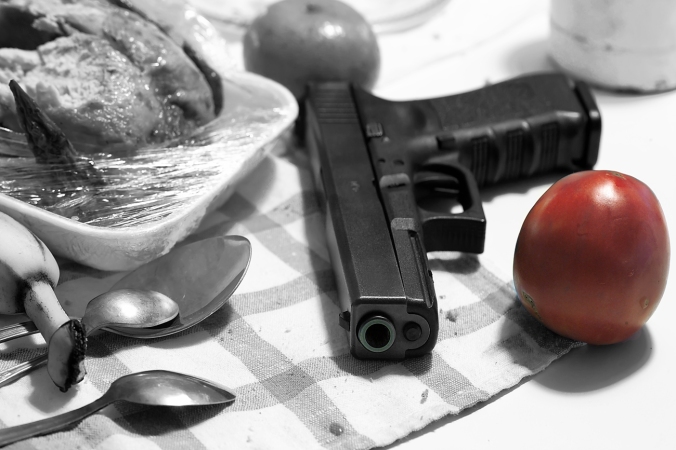
Would you believe there was actually a pic of a gun and a tomato in Shutterstock? I wrote the first paragraph before looking for a pic, and I didn’t doctor this photo. Shutterstock is a strange place. (Shutterstock photo)
If there’s an equivalent of that kind of nuance in the firearm world, it’s with the rifle calibers .223 and 5.56mm, along with .308 and 7.62mm. If you decide to go down a more technical route in your writing, you might wind up getting mighty confused. And if this is new to you, prepare to learn how to be confused by it.
As Usual, Blame the Metric System

Remember the time NASA lost a Mars orbiter in 1999 because one development team used Imperial measurements and another used the metric system? It’s like that, but with guns. (Shutterstock photo)
The classic example of this is with the .223 (Imperial units) caliber, which is similar to the 5.56mm (metric system). Both are expressions of the diameter of the bullet, which is how a firearm caliber is defined. A .223 caliber bullet, for example, has a diameter of 223/1,000 inches. That’s nearly the same diameter as a 5.56mm bullet, with only a tenth of a millimeter difference.
Because of this hair’s worth of difference, it’s often said the .223 caliber is equivalent to the 5.56mm. So why are there two different ways of writing essentially the same caliber?
It’s because they’re not identical and shouldn’t be written interchangeably if you can help it. Gun Digest offers an extensive history of these two calibers, and it’s worth a read if you have time. If you don’t, here’s the shortcut.
The Difference Between the .223 and the 5.56mm Calibers
The 5.56mm caliber can accept higher pressures when fired than the .223. That’s the difference. This tolerance allows for a heavier hit on a target, which is why the 5.56mm is most often cited for military firearms while the .223 is relegated to the civilian world.
There’s more to it than that, but that’s the gist that will score you points at cocktail parties.
A Great Example: The AR-15 and the M16
There’s no better example of this in action than the AR-15 and the M16. They started off as the same gun back in the 1950s. However, one version was adopted by the U.S. military and the other hit the civilian world. Their respective calibers followed suit.
The AR-15 is a .223 caliber rifle, which makes it best suited for civilian purposes such as sport shooting, hunting and self-defense. Here’s what it looks like:
The M16, on the other hand, must meet certain performance specifications standardized across the U.S. military. That means higher pressures, which is why it uses 5.56mm ammunition. It looks like this: These calibers are only one of the slight differences between the AR-15 and the M16, which you can read more about here.This same thing happens with .308 (Imperial) and 7.62mm (metric) calibers. The .308 is cut out for civilian work while the 7.62mm is for military purposes, despite the bullets having nearly identical diameters.
Two Reasons Why This Matters for Writing Weapons

You say “tomato sheriff,” I say “that’s a new take on the spaghetti Western.” And we all groan. (Shutterstock photo)
First, if you research a firearm and the specs list a caliber written in a certain way, follow that style even if there is an Imperial or metric equivalent. If a gun is listed as a .223, don’t call it a 5.56mm. Likewise, don’t make an unnecessary conversion even if there isn’t an established equivalent. For instance, don’t change a 10mm handgun to a .39 caliber just because you have a conversion program on your calculator and it’s the Fourth of July.
Second, military firearms’ calibers are usually (but not always) written using the metric system. That’s true for militaries around the world.
Two Other Quick Points
Metric and Imperial calibers’s decimal points are written differently. You can read more about that here.
Also, metric calibers sometimes include an X and an extra number at the end, as in 5.56x45mm. That “x45” refers to the length of the cartridge case in millimeters. This denotes different versions of the 5.56mm caliber.
Imperial calibers don’t use an X and an extra number. Instead, you’ll see words to describe variations of length within the caliber, such as .22 Long Rifle or .22 Short.
Get the Book
 The Writer’s Guide to Weapons: A Practical Reference for Using Firearms and Knives in Fiction (Writer’s Digest Books) comes with everything but the ammo. Pick up a print or digital copy from these fine retailers:
The Writer’s Guide to Weapons: A Practical Reference for Using Firearms and Knives in Fiction (Writer’s Digest Books) comes with everything but the ammo. Pick up a print or digital copy from these fine retailers:


You say Red Squishy Thing I wonder: Angry Octopus? 😉
Hm… tomatoes are fruits, not vegetables? Ah, I go simpleton, combining it into ‘veggy stuff’. They do make a good basic ingredient for pizza, and tomato soup can be more tasteful than the cheap, salty dish most were forced to know as children.
This one gives solid info to any author writing about ammunition or the tricky differences between the Metric System and the Imperial.
http://www.imdb.com/title/tt0099935/?ref_=fn_al_tt_4
LikeLike
Actually, the “45” in the 5.56×45 cartridge designation does not refer to the length of the bullet–but to the length of the cartridge case. The same system is used in designating the details of other cartridges such as the 7.62×39 caliber (also known as the 7.62 Russian or–more loosely–as the “AK-47 cartridge”). I assume, of course, that everybody reading this discussion is savvy enough to know that “bullet” should be used to refer to the flying projectile and not to the entire cartridge or to the ammunition in general. Those interested in such esoterica should refer to Frank Barnes’ book “Cartridges of the World” which is a standard reference in such matters.
LikeLike
Right you are, I’ll fix that in the article. Even I make a boo-boo from time to time. Yes, Cartridges of the World is an excellent book. We publish it at my work.
LikeLike
Hi, Ben–Thanks for your response, and for your willingness to exchange views and details with readers. I continue to enjoy reading the articles on line, and I do pick up useful info as well as interesting stuff from the writers’ perspectives. By the way–I THOUROUGHLY enjoyed the title that referred to the “sqishy red thing”! Much fun. I hope you are enjoying the warmer weather as I am–one of these days soon it’ll be pleasant enough to spend some time at the range. . . .
Hang in there!
LikeLiked by 1 person